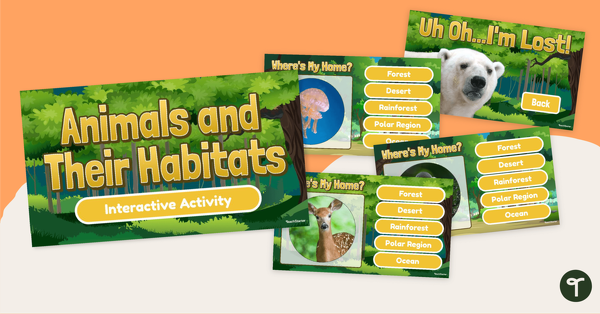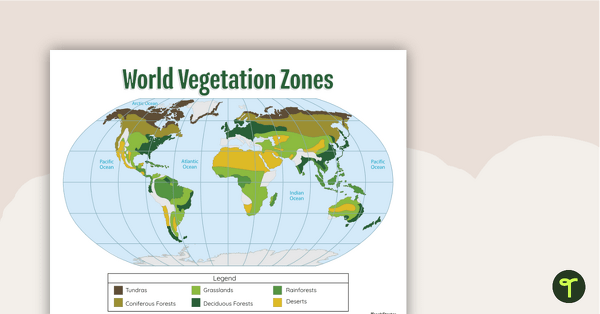Climate Teaching Resources
Teach students about climate change, the difference between climate and weather, and more with worksheets, activities, printables, and digital teaching resources from Teach Starter.
These curriculum-aligned science resources were designed to help you lesson plan with editable options that can be easily adapted to differentiate instruction for individual students.
Looking for help to build your climate lesson plans? Read on for a primer from our teacher team!
What Is Climate?
Often confused with the term "weather" by young science learners, climate refers to the long-term patterns of temperature, humidity, wind, and precipitation in a given area. It's determined by a variety of factors, from the Earth's orbit and tilt to the amount and distribution of greenhouse gases in the atmosphere and the presence of land masses and bodies of water.
Climate can change naturally over time, but it's also heavily influenced by human activities, including the burning of fossil fuels and deforestation.
What Is the Difference Between Climate and Weather?
This is a question we hear often from students! They are closely related as climate is the "average weather" over a period of time — typically 30 years or more —and describes a region's typical conditions.
This explanation may help clear things up for your students:
- Climate refers to the long-term patterns of temperature, humidity, wind, and precipitation in a given area, while weather refers to the short-term conditions of the atmosphere at a specific time and place.
- Weather can change from hour to hour, day to day, and season to season. Climate covers the weather over a long period of years.
- Climate is the general trend or pattern of weather in an area, while weather is the specific state of the atmosphere at a given time.
What Is Climate Change?
Are your students hearing about climate change at home or on the news and asking what makes it different from climate itself? Here's how to answer.
Climate change refers to the long-term shifts in temperature, precipitation, wind patterns, and other measures of climate that occur over several decades or longer.
These changes can be caused by natural factors — such as changes in the Earth's orbit — but the term is most commonly used to refer to changes that are caused by human activities, particularly the burning of fossil fuels and deforestation, which release large amounts of greenhouse gases into the atmosphere.
These gases trap heat from the sun, causing the Earth's temperature to rise, which in turn leads to changes in weather patterns, sea levels, and the behavior of plants and animals.
Climate change can have a variety of negative impacts on the environment, human health, and the global economy.
How to Teach Kids About Climate
Teaching about climate is an important part of the elementary science curriculum, and here are a few tips to get started!
- Make it real with hands-on activities: These can include experiments, field trips, and projects that allow students to observe and measure different aspects of climate firsthand.
- Engage students in class discussions: Encourage students to share their thoughts and ideas about climate change and engage in critical thinking and problem-solving.
- Get students involved in role-playing: Have students act out scenarios related to climate change, such as negotiating international agreements on emissions reductions or responding to natural disasters.
- Emphasize the importance of personal and community action: Encourage students to think about how they can reduce their own carbon footprint and advocate for climate-friendly policies in their community.
- Free Plan

Weather Word Wall Vocabulary
Use this teacher-created weather resource to teach weather vocabulary. Build a word wall with your students during your weather lessons.
- Plus Plan

Deciduous Forest Biome Slide Deck
An 11-slide editable PowerPoint to use in the classroom when learning about deciduous forests.
- Plus Plan

Weather Versus Climate Poster
A poster explaining the difference between weather and climate.
- Plus Plan

Who Would Win? - Plant Adaptation Interactive Game
Identify plants and plant adaptations that allow for survival in different environments with an exciting “Who Would Win?” showdown game!
- Plus Plan

Climate Zones of the World – Poster Pack
Learn about different climate types with this set of 6 printable posters.
- Plus Plan

Animals and Their Habitats- Interactive Activity
Help a lost polar bear (and his friends) return to the correct habitat with a Google Slides interactive activity.
- Plus Plan

World Biomes Map
Locate and explore the different biomes of the world with this engaging classroom poster.
- Plus Plan

Dressing for the Physical Environment Sorting Activity
Help children learn about dressing for the environment by sorting clothing items into categories for warm climate and cold climate.
- Plus Plan

World Vegetation Zones - Mapping Template
Locate and explore different vegetation zones around the world with this mapping worksheet.
- Climate Posters
- Climate Games
- Climate Interactive Activities
- Climate Instructional Slide Decks
- Climate Word Walls
- Climate Sorting Activities
- Climate Templates
- Climate for Kindergarten
- Climate for 1st Grade
- Climate for 2nd Grade
- Climate for 3rd Grade
- Climate for 4th Grade
- Climate for 5th Grade
- Climate for 6th Grade